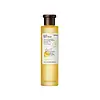What's inside
What's inside
 Key Ingredients
Key Ingredients

 Benefits
Benefits

 Concerns
Concerns

 Ingredients Side-by-side
Ingredients Side-by-side

Citrus Junos Fruit Extract 93%
Skin ConditioningNiacinamide
Smoothing1,2-Hexanediol
Skin ConditioningPPG-13-Decyltetradeceth-24
EmulsifyingPolyglyceryl-10 Laurate
Skin ConditioningSodium Ascorbyl Phosphate
AntioxidantCitrus Aurantium Bergamia Fruit Oil
MaskingCitric Acid
BufferingSodium Citrate
BufferingCitrus Tangerina Peel Oil
MaskingDipotassium Glycyrrhizate
HumectantCaramel
Cosmetic ColorantJuniperus Mexicana Oil
MaskingCaprylic/Capric Triglyceride
MaskingDiacetyl Boldine
Skin ConditioningLimonene
PerfumingLinalool
PerfumingCitrus Junos Fruit Extract 93%, Niacinamide, 1,2-Hexanediol, PPG-13-Decyltetradeceth-24, Polyglyceryl-10 Laurate, Sodium Ascorbyl Phosphate, Citrus Aurantium Bergamia Fruit Oil, Citric Acid, Sodium Citrate, Citrus Tangerina Peel Oil, Dipotassium Glycyrrhizate, Caramel, Juniperus Mexicana Oil, Caprylic/Capric Triglyceride, Diacetyl Boldine, Limonene, Linalool
Water
Skin Conditioning2-O-Ethyl Ascorbic Acid
Skin ConditioningDipropylene Glycol
HumectantPropylene Glycol
HumectantGlycereth-26
HumectantPolyglycerin-10
HumectantNiacinamide
SmoothingActinidia Chinensis Fruit Extract
EmollientButylene Glycol
Humectant1,2-Hexanediol
Skin ConditioningHydroxyacetophenone
AntioxidantCarbomer
Emulsion StabilisingCetyl Ethylhexanoate
EmollientHydrogenated Vegetable Oil
EmollientStearic Acid
CleansingCanola Oil
EmollientAminomethyl Propanol
BufferingAscorbyl Tetraisopalmitate
AntioxidantSodium Polyacrylate
AbsorbentBacillus/Soybean Ferment Extract
Skin ConditioningParfum
MaskingLactobacillus/Milk Ferment Filtrate
Skin ConditioningSodium Hyaluronate
HumectantDisodium EDTA
Menthyl Lactate
MaskingTetrahydropiperine
Skin ConditioningPentylene Glycol
Skin ConditioningHydrolyzed Royal Jelly Protein
Skin ConditioningSodium Metabisulfite
AntioxidantFolic Acid
Skin ConditioningWater, 2-O-Ethyl Ascorbic Acid, Dipropylene Glycol, Propylene Glycol, Glycereth-26, Polyglycerin-10, Niacinamide, Actinidia Chinensis Fruit Extract, Butylene Glycol, 1,2-Hexanediol, Hydroxyacetophenone, Carbomer, Cetyl Ethylhexanoate, Hydrogenated Vegetable Oil, Stearic Acid, Canola Oil, Aminomethyl Propanol, Ascorbyl Tetraisopalmitate, Sodium Polyacrylate, Bacillus/Soybean Ferment Extract, Parfum, Lactobacillus/Milk Ferment Filtrate, Sodium Hyaluronate, Disodium EDTA, Menthyl Lactate, Tetrahydropiperine, Pentylene Glycol, Hydrolyzed Royal Jelly Protein, Sodium Metabisulfite, Folic Acid
Alternatives
Ingredients Explained
These ingredients are found in both products.
Ingredients higher up in an ingredient list are typically present in a larger amount.
1,2-Hexanediol is a synthetic liquid and another multi-functional powerhouse.
It is a:
- Humectant, drawing moisture into the skin
- Emollient, helping to soften skin
- Solvent, dispersing and stabilizing formulas
- Preservative booster, enhancing the antimicrobial activity of other preservatives
Niacinamide is a multitasking form of vitamin B3 that strengthens the skin barrier, reduces pores and dark spots, regulates oil, and improves signs of aging.
And the best part? It's gentle and well-tolerated by most skin types, including sensitive and reactive skin.
You might have heard of "niacin flush", or the reddening of skin that causes itchiness. Niacinamide has not been found to cause this.
In very rare cases, some individuals may not be able to tolerate niacinamide at all or experience an allergic reaction to it.
If you are experiencing flaking, irritation, and dryness with this ingredient, be sure to double check all your products as this ingredient can be found in all categories of skincare.
When incorporating niacinamide into your routine, look out for concentration amounts. Typically, 5% niacinamide provides benefits such as fading dark spots. However, if you have sensitive skin, it is better to begin with a smaller concentration.
When you apply niacinamide to your skin, your body converts it into nicotinamide adenine dinucleotide (NAD). NAD is an essential coenzyme that is already found in your cells as "fuel" and powers countless biological processes.
In your skin, NAD helps repair cell damage, produce new healthy cells, support collagen production, strengthen the skin barrier, and fight environmental stressors (like UV and pollution).
Our natural NAD levels start to decline with age, leading to slower skin repair, visible aging, and a weaker skin barrier. By providing your skin niacinamide, you're recharging your skin's NAD levels. This leads to stronger, healthier, and younger looking skin.
Another name for vitamin B3 is nicotinamide. This vitamin is water-soluble and our bodies don't store it. We obtain Vitamin B3 from either food or skincare. Meat, fish, wheat, yeast, and leafy greens contain vitamin B3.
The type of niacinamide used in skincare is synthetically created.
Learn more about Niacinamide